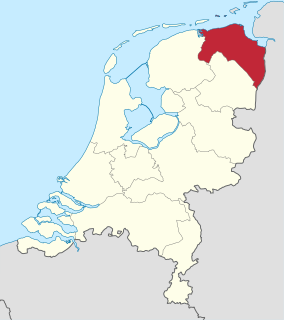
Groningen is the northeasternmost province of the Netherlands. It borders on Friesland to the west, Drenthe to the south, the German state of Lower Saxony to the east, and the Wadden Sea to the north. As of November 2019, Groningen had a population of 585,881 and a total area of 2,960 km2 (1,140 sq mi).
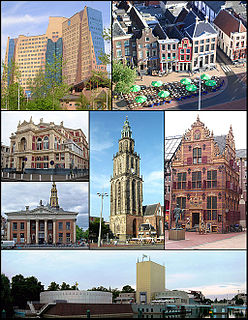
Groningen is the capital city and main municipality of Groningen province in the Netherlands. It is the largest city in the north of the Netherlands. As of December 2021, it had 235,287 inhabitants. It has a land area of 168.93 km2 (65.22 sq mi), and a total area, including water, of 180.21 km2 (69.58 sq mi). Its population density is 1,367 residents per km2. On 1 January 2019, it was merged with the municipalities of Ten Boer and Haren. The Groningen-Assen metropolitan area has about half a million inhabitants. Groningen is a university city, and students comprise an estimated 25% of its total population. Groningen was established more than 950 years ago. Historically, it was a semi-independent city-state, a member of the Hanseatic League, and the dominant regional power in the north of the Netherlands.

Drenthe is a province of the Netherlands located in the northeastern part of the country. It is bordered by Overijssel to the south, Friesland to the west, Groningen to the north, and the German state of Lower Saxony to the east. As of November 2019, Drenthe had a population of 493,449 and a total area of 2,680 km2 (1,030 sq mi).

Appingedam is a city and former municipality in the northeastern Netherlands. Although there is no certainty as to the exact age of Appingedam, historical research demonstrates that the place in which the city would eventually be built had been inhabited for over a millennium. Specifically, the area in which the earliest traces of human settlements have been reported is the Wierde, a quarter located in the northern part of the city centre. Today, a narrow, winding street by the same name runs along the waterfront as a living testimony to the times gone by. The characteristic landmarks of the old Wierde are still recognisable today: the historical East-West Canal, called “Diep,” dug to the south of the Wierde, diked on both sides, still defines the unique layout of the downtown Appingedam.
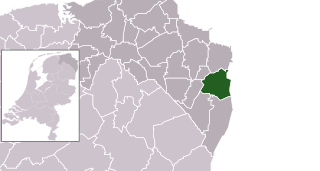
Bellingwedde was a municipality with a population of in the province Groningen in the northeast of the Netherlands. Bellingwedde was established in 1968, when the municipalities of Bellingwolde and Wedde had merged. It contained the villages Bellingwolde, Blijham, Oudeschans, Veelerveen, Vriescheloo, and Wedde. After almost 50 year, Bellingwedde was disestablished in 2018, when the municipalities of Bellingwedde and Vlagtwedde had merged into Westerwolde.

Delfzijl is a city and former municipality with a population of 25,651 in the province of Groningen in the northeast of the Netherlands. Delfzijl was a sluice between the Delf and the Ems, which became fortified settlement in the 16th century. The fortifications were removed in the late 19th century. Delfzijl is the fifth largest seaport in the Netherlands, and the largest port in the North East of the country.

Loppersum is a village and former municipality with a population of 10,174 in the province of Groningen in the northeast of the Netherlands.

Winschoten is a city with a population of 18,518 in the municipality of Oldambt in the northeast of the Netherlands. It is the largest city in the region of Oldambt in the province of Groningen which has 38,213 inhabitants.
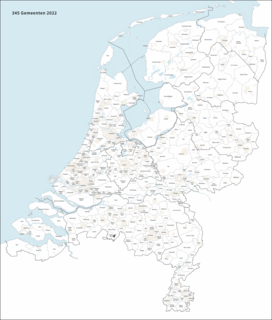
As of January 2022, there are 345 municipalities and three special municipalities in the Netherlands. The latter is the status of three of the six island territories that make up the Dutch Caribbean. Municipalities are the second-level administrative division, or public bodies, in the Netherlands and are subdivisions of their respective provinces. Their duties are delegated to them by the central government and they are ruled by a municipal council that is elected every four years. Municipal mergers have reduced the total number of municipalities by two-thirds since the first official boundaries were created in the mid 19th century. Municipalities themselves are informally subdivided into districts and neighbourhoods for administrative and statistical purposes.
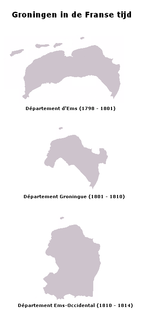
Ems-Occidental was a department of the First French Empire in the present-day Netherlands and Germany. It was formed in 1810, when the Kingdom of Holland was annexed by France. Its territory corresponded more or less with the present Dutch provinces of Groningen and Drenthe. Its capital was Groningen. The department was subdivided into the following arrondissements and cantons :

Bellingwolde is a village with a population of 2,655 people in the municipality Westerwolde in the Netherlands. It is situated in the southeast of the region Oldambt, in the north of the region Westerwolde, and in the east of the province Groningen, at the border with Germany.
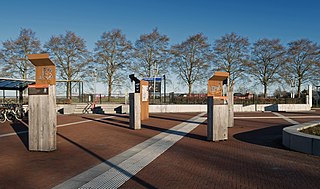
Appingedam is a railway station in the city of Appingedam, Netherlands. The station was opened on 15 June 1884 and is located on the Groningen–Delfzijl railway. Nowadays the station is unstaffed. Only basic platform facilities, as a shelter and a ticket machine, remain. The station is owned by ProRail and operated by Arriva.
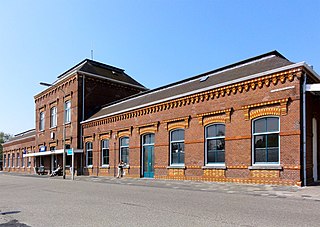
Delfzijl is a railway station in Delfzijl, Netherlands. It is located on the Groningen–Delfzijl railway after Delfzijl West as the terminus for passengers. The railway line continues further east, but only for freight trains. The station building was completed in 1883 and train services started on 15 June 1884. The trains are currently operated by Arriva.

Delfzijl West is a railway station located in Delfzijl, Netherlands. It is located on the Groningen–Delfzijl railway between Appingedam and Delfzijl. The station was opened on 1 June 1969. The train services are operated by Arriva.
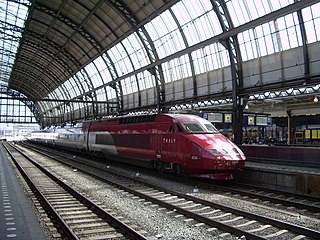
High-speed rail service in the Netherlands started at 13 December 2009 with the dedicated HSL-Zuid line that connects the Randstad via Brussels to the European high-speed rail network. In later years improved traditional rail sections were added to the high-speed network. Proposals for more dedicated high-speed lines were deemed too costly; plans for the HSL-Oost to Germany were mothballed and instead of the Zuiderzeelijn the less ambitious Hanzelijn was built to enable future high-speed service between the northern provinces and the Randstad.

Oldambt is a municipality with a population of 38,129 in the province of Groningen in the Netherlands. It was established in 2010 by merging the municipalities of Reiderland, Scheemda, and Winschoten. It contains the city of Winschoten and these villages:

Winschoten is an unstaffed railway station in Winschoten in the Netherlands. It is located on the Harlingen–Nieuweschans railway between Scheemda and Bad Nieuweschans in the province of Groningen.
The 2013 Energiewacht Tour is the third edition of the Energiewacht Tour women's cycling stage race. It is rated by the UCI as category 2.2, and is held between 3 and 7 April 2013 in the Netherlands. Twenty-four teams of 6 riders take part. There is also an Energiewacht Tour for junior riders from 5 to 7 April 2013.

Wirdum is a small rural village in the province of Groningen in the Netherlands. It is situated close to the Damsterdiep - a channel connecting the city of Groningen to Delfzijl - on two artificial dwelling hills, known locally as 'Wierden'. As of 2013, Wirdum had a population of 300.

Eemsdelta is a municipality in the province of Groningen, Netherlands formed from the merger of Appingedam, Delfzijl and Loppersum. The municipality came into existence on 1 January 2021.




















